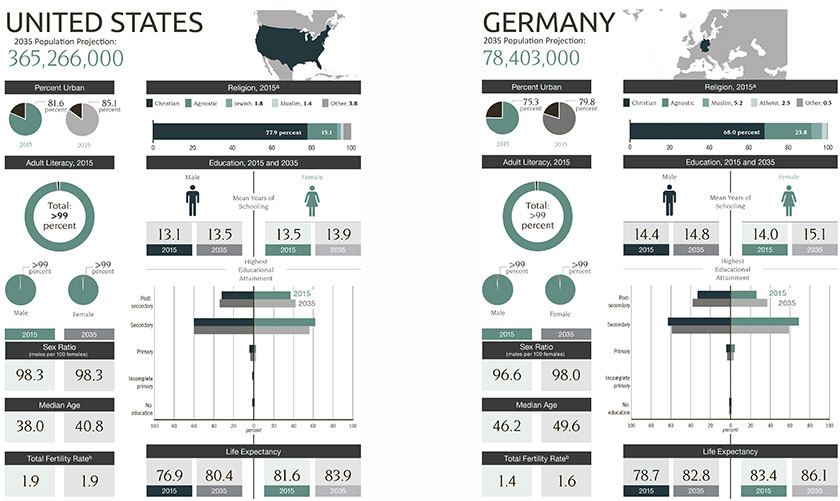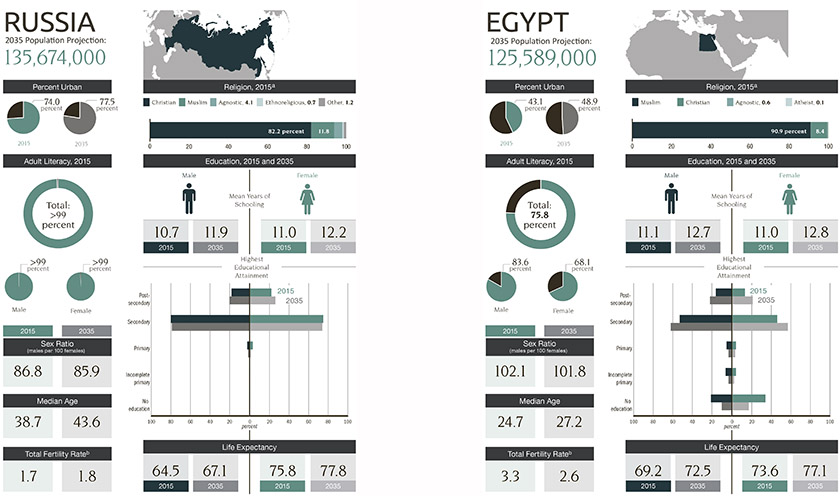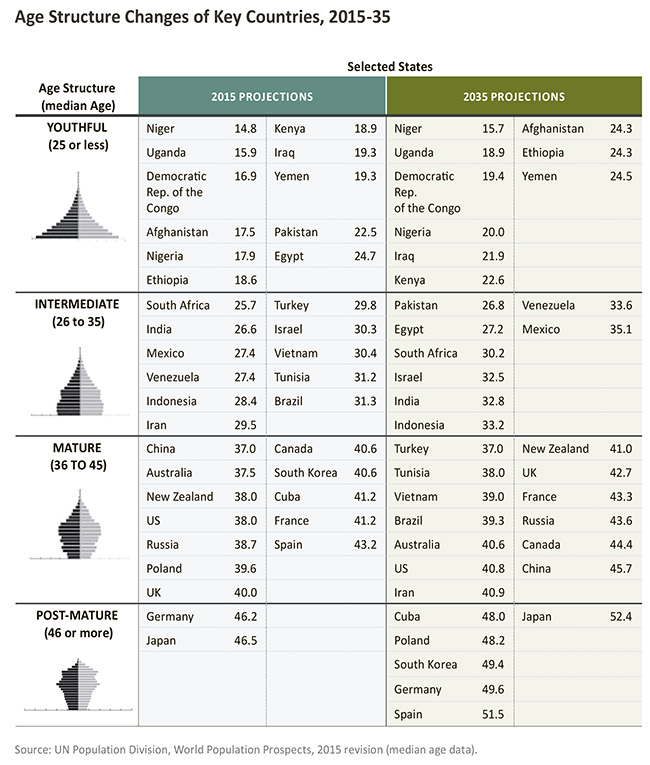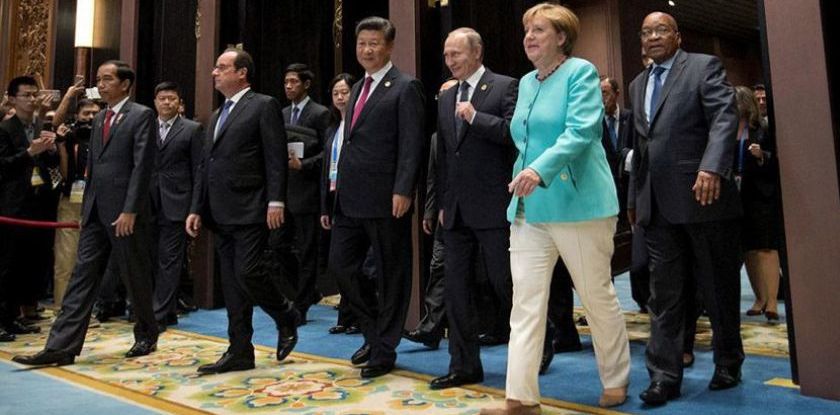The world is due for a major shakeup and only sustainable governments will be able to withstand it. Such conclusion can be drawn from the report titled “Paradoxes of progress”, published by the national intelligence council of the US this January. In it, there is an analysis of major tendencies that will determine the development of world civilization throughout the next decades.
First, however, a few words about the National Intelligence council. It is a famous analytical center, serving the needs of all of intelligence community of USA, in which there are 16 independent agencies. Based on the data, presented by US security services, they develop mid-term urgency and long-term urgency forecasts of development of countries, continents and the entire world.
The goal of the “Paradoxes of progress” report is to present development prospects for the world community for the period up to 2035. They come down to three scenarios, each of which represents a different mix of the “game” of 7 mega-trends. Let’s note that the trends themselves were outlined after a discussion in the expert community (interviews were conducted with 2500 people from 35 countries). But its doubtful that operatives-analysts, preparing this report in 2016, assumed that their choice of name will be so appropriate. Because, the new president Trump, like no other can claim the role of the abovementioned “paradox of progress”.
Whatever the case is, the main conclusion of the report’s authors is this: expected future will be filled with all sorts of conflicts, and perspectives of survival of civilizations will depend on the ability to identify and solve these conflicts. The outlined megatrends then will be the generators of these conflicts.
We presented them on the graph (we divided it into parts) and included main components of aforementioned trends. As a result we got a map of “main world problems” forming the future of the world.
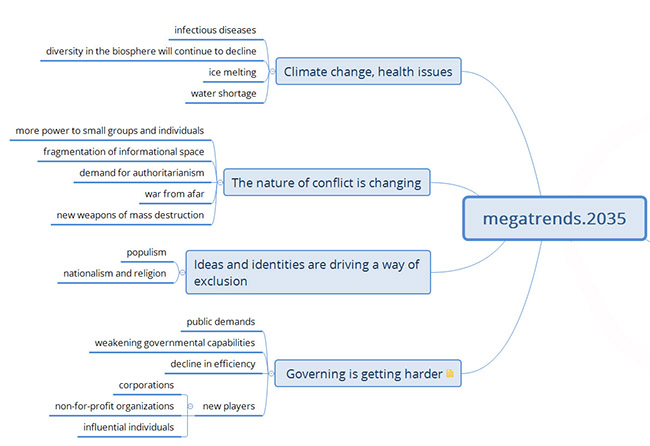
The first part of the scheme
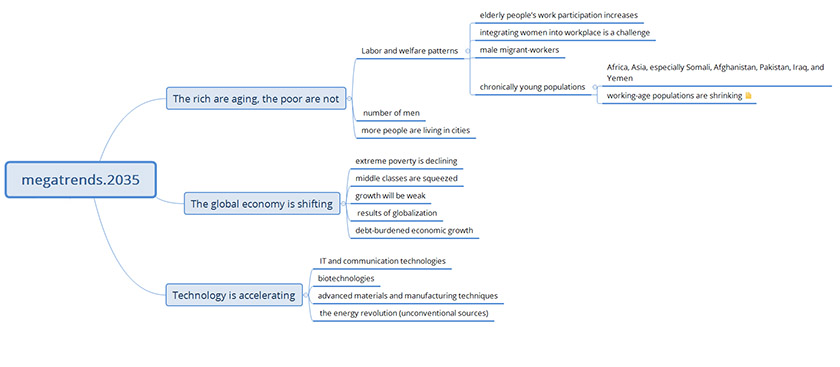
The second part of the scheme
And now a little more about the megatrends themselves.
I. The rich are getting older, the poor are not.
- The fastest growing population group in the world are people over 60. Society needs to learn to bring older people back to work in order to compensate for the loss in the labor force. Leaders in the loss of working population will be Europe and China.
- Young generation of so-called chronically young countries will grow at a fast rate, with this countries often being the poorest ones and unable to create normal conditions for labor and professional education.
- A separate problem is integration of working women into the cohort.
- Growth of urban civilization. BY 2050, two thirds of world population will live in cities. This will require a radical overview of principles and level of social services in correspondence with new needs.

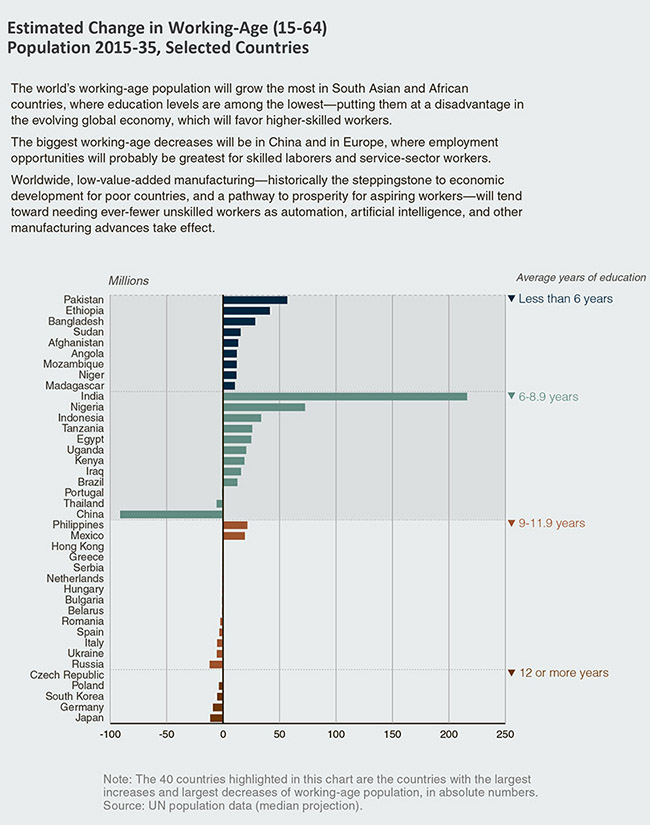
II. A move in the center of world’s economy – an unexpected reality
- A decrease in labor force and output of labor in large countries will happen in the backdrop of burden of high debt, weakening demand and public concerns regarding positive results of globalization.
- In the period from 1989 to 2008, as a result of globalization there was a decrease of relative numbers of two social groups – the poorest ones (in China and Asia in general) and middle class – in developed countries. This will definitely play a role in the future.
- China is trying to change its economy from an investment, export-oriented model to a consumer-based model.
- A decrease in the rate of growth threatens a decrease in the rate of eradication of poverty, in developing countries.
- Technological acceleration – deepening of the abyss
- Technologies speed up progress, but they also lead to widening of the gap between winners and losers.
- An accelerated development of cybernation and artificial intelligence threatens rapid changes for the economy, as a result of which a traditional mechanism of development of poor countries will be over.
- A leap in biotechnology (first of all in the abilities of editing a genome) will be revolutionary in medicine, but will also draw attention to many ethical problems.
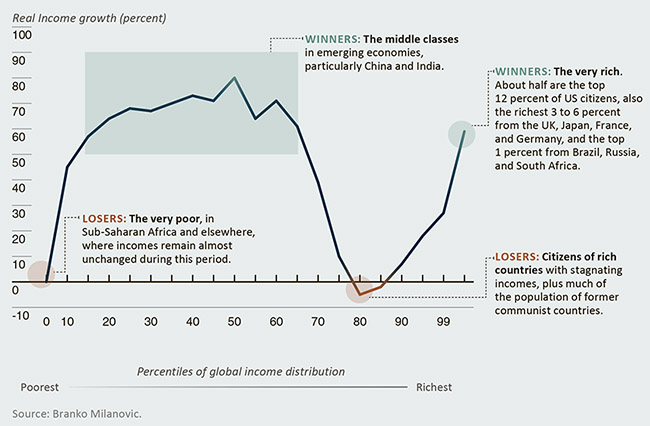
III. Government administration becomes more difficult – demand grows, supply decreases.
- A growing difficulty of government management is a result of several factors.
- First of all, constituent demands grow, as they demand economic prosperity and national security at the same time.
- At the same time opportunities of the government itself decrease; reasons are stagnating government income, rising atmosphere of distrust, etc.
- As a result, growing number of challenges of governmental powers with a fixed or decreasing toolbox of resources, leads to decrease in effectiveness.
- Pressure on a government and partial replacement of its functions by NGOs, corporations and influential people rises. Both due to the number of such players and due increase in their political weight.
IV. Idea and identity diverging – “exclude and conquer”.
- Nationalism, as a form of populism will be used as an instrument to consolidate nations. It will be especially active in China, Russia, Turkey and other countries where leaders will strive for a total control of domestic politics.
- Any inner alternatives to such regime will be annihilated, and the system of international relations will be portrayed as a threat to inner peace.
- In a similar scenario of supporting exclusive identity, but in a religious form, countries of middle east and north Africa will develop too.
- Religious identity will stay as the main social bond between people. Its role will even rise, due to increased birth rates in regions, where religion plays a big role.
- In Russia, national and religious identity will unite in order to have a more complete control.
- Research done by Pew Research in US, shows that “religiosity factor” itself, characterizing level of religiosity of an individual is a more reliable predictor of constituent’s behavior, than an affiliation with a particular religion. This means that politicians will use this lever in order to mobilize their constituents.
V. Changes in the nature of conflict – new war of a new generation
- Possibility of occurrence and escalation of various conflicts (including inter-state ones) will rise. This is explained by difficult relations between large states, terrorist threats, and new technologies.
- New strategies, technologies as well as geopolitical context change the characters of conflict and type of armament that are used in it.
- Future conflicts, will be aimed at destroying objects of infrastructure, systems of social connection as well as government functions.
- Goals of future conflicts might include achieving advantage of psychological and geopolitical character.
- Abilities of waging wars from “afar” widened and allow for distant strikes not only by governments but also by small groups.
- Occurrence of new advanced technologies (especially in biosphere) significantly lower threshold for possibility of them being acquired.
- Mass spread of “grey conflict zones”, where there is no clear war and peace border.
- Climatic changes, healthcare, epoch of ecological deficite.
- Public demands for hardening of ecological norms will collide with the need of their approval on a global basis.
- “Ecological awakening” of the population of developing countries and of “new” developed countries (especially China).
- Water deficit in 2035 will be experienced by half of Earth’s population.
- Strengthening of global ties will lead to rise in infectious diseases, difficult for quick detection and liquidation.
- Age-related diseases related to lifestyle and nutrition will dominate.
All of these aforementioned trends are interesting from the standpoint of general understanding of world problems. However, we decided not to limit ourselves with a generic outlie of these issues, but to formulate (in global terms) main prospects for Kazakhstan. As a result we got a project called “Megatrends Kazakhstan” – a so-called reference for the future administration. That will be discussed in our next article.
Below are a few more illustration from the report and some interesting numbers.
